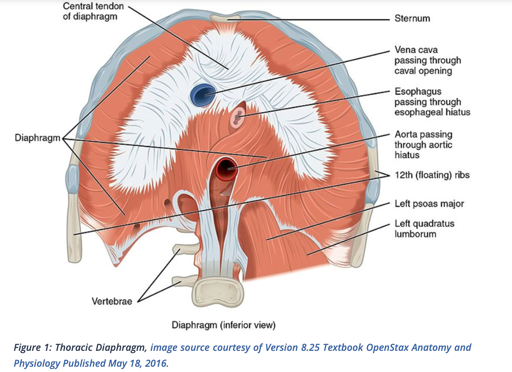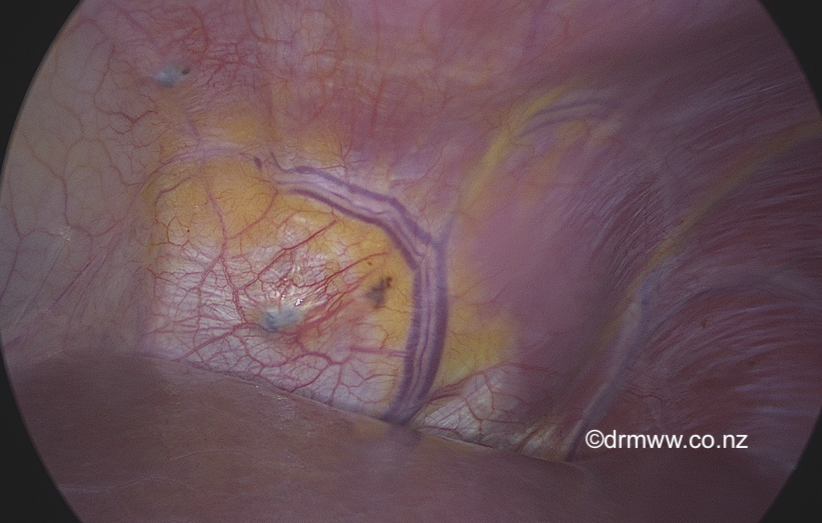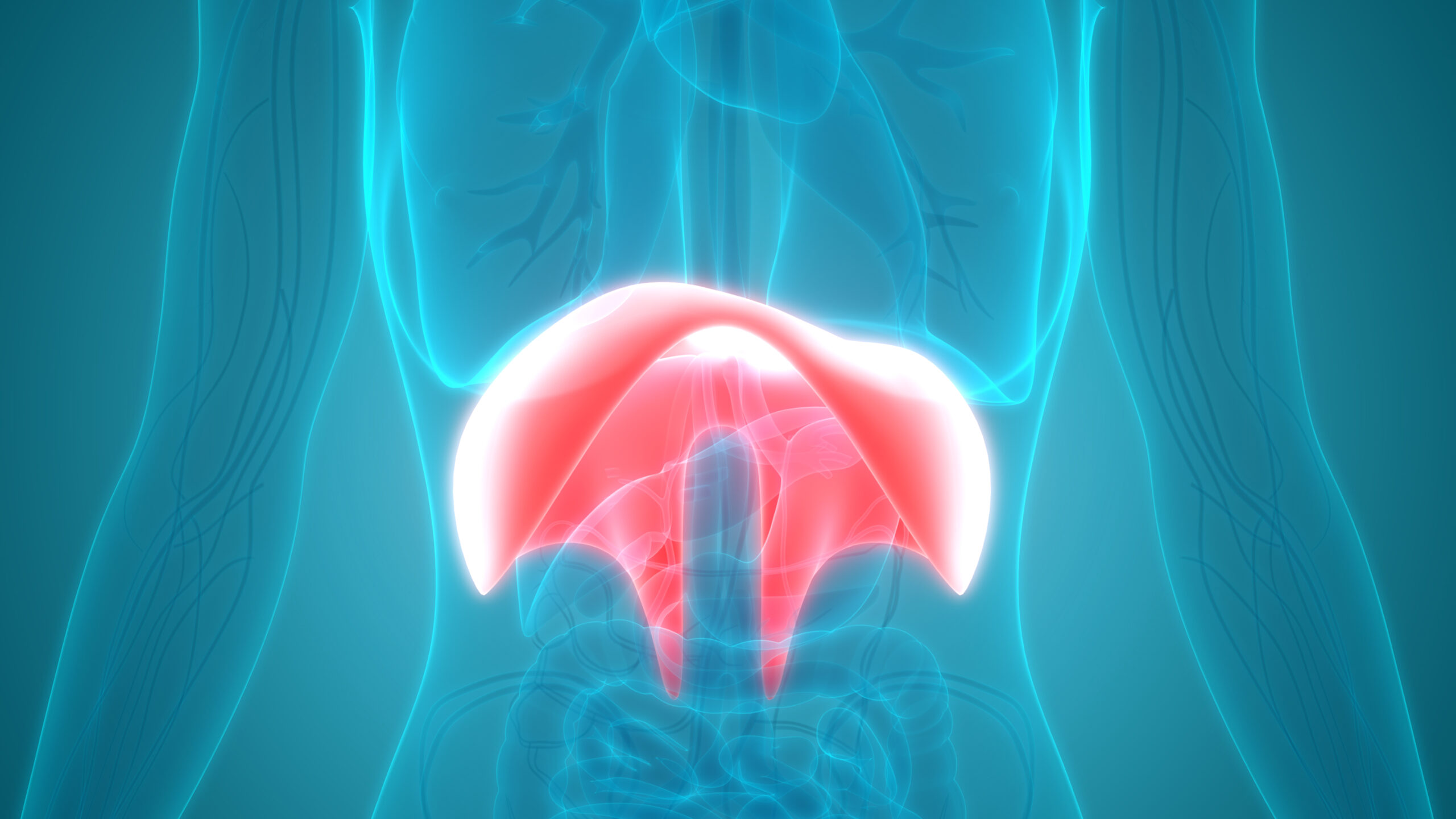Warning: This post contains surgical imagery that some may find graphic.
Endometriosis is the presence of tissue similar to that of the endometrial lining that grows outside of the uterus. It is a chronic inflammatory condition that affects up to 11% of girls, women, individuals in the transgender community and people who are non-binary who may not identify as women. The majority of people have endometriosis in and around the pelvic organs, the pelvic peritoneum and the ovaries. About 12% of people will end up with endometriosis higher in the pelvis (known as extra-pelvic endometriosis) or the lower abdomen in the bowel wall (rectum, sigmoid, caecum, small bowel). It is estimated that less than 2% will end up with endometriosis around the right side of the liver and diaphragm. A smaller undetermined number of people will have endometriosis in the chest (thorax) or lungs (Thoracic Endometriosis Syndrome or TES). The true prevalence of this type of endometriosis is unknown as there has been little research beyond case reports in the medical literature.
This blog will focus on endometriosis of the diaphragm (Image 1) and thorax (Image 2). Despite the infrequent diagnosis of endometriosis in these locations, it is an important topic to discuss because of the debilitating symptoms that people can have in this area and the difficulty in finding specialists who have experience managing their care with knowledge and confidence.


Image 1 & 2 The anatomy of the Diaphragm and Thorax
When endometriosis affects the upper abdomen and diaphragm, the symptoms can vary widely. Many isolated lesions may not cause any symptoms at all. Some will experience a range of effects including a slight ache in the right shoulder around the time of the menstrual period, to the more extreme such as cyclical difficulty with taking deep breaths or sitting upright, severe pain radiating from the shoulder to the shoulder blade.
The diaphragm is the muscle and connective tissue layer that separates the abdominal cavity from the thoracic cavity. It is intimately associated with the upper abdominal organs, including the liver and spleen. Directly above, sits the base of the lungs and the sac containing the heart (pericardium). The diaphragm is innervated by cranial nerves C3, 4, and 5. These nerves control and coordinate the motion of the diaphragm to help expand the lungs. However, if there is pain from the diaphragm, it is actually perceived in the shoulder blade and shoulder area. Sometimes patients may have neck or even ear pain due to the shared innervation of the phrenic nerve. The diaphragm is only a few millimetres in thickness. When endometriosis grows there, it can grow attached (adhesions) to the liver and spread through the pleural cavity that contains the lungs. Hence taking deep breaths during a period can be painful.

Image 3 – endometriosis on left diaphragm under the heart.
Endometriosis within the chest cavity is mainly related to lesions that have extended through the diaphragm. About 40% of the lesions will occur within the lung and cause symptoms of cyclical (catamenial) chest pain, cough, shortness of breath, or haemoptysis (coughing blood). In sporadic cases, you can have life-threatening symptoms such as spontaneous lung collapse (pneumothorax) or bleeding into the space that contains the lungs (haemothorax).

Image 4 – typical mild-spot endometriosis on the edge of the right diaphragm.
We don’t know why endometriosis occurs in the pelvis, let alone the diaphragm and the thorax. Several theories could explain its growth in areas well outside of the pelvis. The most likely explanation is related to the theory of embryological cell displacement or coelomic metaplasia. The theories on endometriosis development have been previously covered in Endometriosis Australia blogs. The majority (85% of people) with diaphragmatic endometriosis or TES will also be found to have pelvic endometriosis as well. The majority of the disease (90%) is located on the right side.
An experienced Endometriosis Specialist will initially make the diagnosis based on patient symptoms alongside carefully considered history and examination. Due to the unusual symptoms, people may see various specialists, for example Cardiothoracic Surgeons, Chest Physicians, Physiotherapists, before a diagnosis is made. The majority of investigations and radiological imaging may be negative. Chest X-ray and CT scans are often performed as part of the workup of more common pathologies that would generally explain the persons symptoms. An attempt should be made to confirm the diagnosis with an MRI performed by an experienced Radiologist. The best results seem to be obtained when the images are captured during a menstrual period. If the lesions of endometriosis are large enough, they may be seen as bright white spots. (see image 5 & 6)
Image 5 & 6 Posterior diaphragmatic endometriosis seen on MRI as white spots
Often the best way of identifying endometriosis on the diaphragm is by laparoscopic surgery, and often this is how endometriosis that does not cause any symptoms is found in this area. One of the problems with laparoscopy is that you can generally only see the diaphragm’s front half (see image 7). Endometriosis on the diaphragm is easy to miss in inexperienced hands. In patients who cough up blood on a cyclical basis, a respiratory physician can perform a bronchoscopy (camera down the windpipe and into the lung tubes). This procedure can be complicated, and the lesions are generally microscopic and hard to see, especially in the presence of blood. In cases where endometriosis is growing on the lungs outside surface, an experienced cardiothoracic surgeon can see it by using a laparoscope in the chest cavity (Video-Assisted Thoracoscopic Surgery VATS).
The management of diaphragmatic endometriosis and TES is generally conservative. Initially, management can be achieved with either continuous low dose contraceptives or progestins such as norethisterone. Dienogest (Visanne), a progestin available in Australia, is seen to be better tolerated and more effective than other progestins. These drugs can be considered for patients on a longer-term basis if well accepted. GnRH agonist (Zoladex) can be considered for short-term periods of up to six months if used with the addition of estrogen to prevent osteoporosis and menopausal symptoms. The majority of people can have their symptoms managed with medication. However, for those cases where a hormonal drug is contraindicated (where medication is not tolerated due to side effects) or where a person wishes to achieve a pregnancy, surgery may be required.

Image 7 Right diaphragm endometriosis seen clearly once the right side of the liver has been mobilised
Surgery of the diaphragm or chest cavity will ideally involve an experienced Endometriosis Specialist who will then coordinate the patient’s care with a Hepatobiliary Surgeon or a Cardiothoracic Surgeon, depending on the location and extent of the endometriosis lesions. Diaphragmatic lesions can be managed laparoscopically (key-hole surgery) by an experienced team. The team will perform the excision of superficial lesions or the resection of an area of full-thickness invasion of the diaphragm (See Image 7,8 & 9) . The diaphragm is then repaired with sutures. There are significant risks involved in surgery – such as bleeding from the liver, collapsing of the lung, along with the usual risks of surgery. VATS surgery is performed through the chest wall by a cardiothoracic surgeon; they can resect diaphragmatic endometriosis and lung endometriosis using surgical staplers. There can be significant pain issues following surgery, and a chest drain may be required for a few days after the operation. On some occasions, open surgery of the upper abdomen and chest may be necessary.
Image 8- View through to the pleural cavity from the upper abdomen after resection of a large area of full-thickness diaphragmatic endometriosis. The collapsed lung is seen on the right.

Image 9 – Full-thickness diaphragmatic endometriosis after removal from the abdominal cavity
Recurrence after surgery by an experienced multidisciplinary team is less than 5%. Hormonal suppression can be considered after surgery if acceptable. As with pelvic endometriosis, in cases where pain has been present for many years, persistent pain may still be experienced despite complete excision of diaphragmatic and thorax endometriosis.
Extra-pelvic endometriosis in the diaphragm and thorax is found in less than 2% of people with pelvic endometriosis, but the true incidence is unclear due to limited research. The symptoms can vary from mildly irritating to severely debilitating, to life threatening. This kind of endometriosis can be challenging to diagnose and investigate. For the people experiencing symptoms, it can be frustrating to find a team of specialists with experience and knowledge to manage symptoms. When symptoms don’t respond to initial hormonal suppression, intervention by an experienced surgical team, led by an Endometriosis Specialist, may be indicated.
Ending on a positive note, the recent release of the RANZCOG Australian Endometriosis Guidelines has recommended of the establishment of Endometriosis Centre of Excellence in Australia. This will hopefully allow people with endometriosis effecting their diaphragm and chest to have better access to specialist teams providing improved diagnosis and treatment options where-ever they live in Australia
Written by,
Dr Michael Wynn-Williams, member of our Clinical Advisory Committee.













